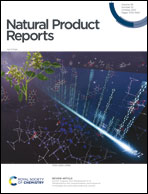Differences in diterpenoid diversity reveal new evidence for separating the genus Coleus from Plectranthus†
Abstract
Covering: up to 2019
The large and medicinally important tropical plant genus Plectranthus (Lamiaceae) was recently split into three separate genera on the basis of molecular and morphological evidence; Plectranthus sensu stricto, Coleus and Equilabium. We found striking differences between the diterpenoids which strongly support this taxonomic split. Coleus is characterised by abietanes oxygenated at C-14 such as royleanones, spirocoleons and acylhydroquinones, which could be useful chemotaxonomic markers to distinguish this genus from Plectranthus s.s. In contrast, the abietanes in Plectranthus s.s. lack C-14 oxygenation, but are often acylated with unusual acids. Equilabium species do not seem to produce diterpenoids. The structures of the nearly 240 abietanes so far reported from Coleus and Plectranthus and their distribution are presented. The aim of this Highlight is to provide an overview of the differences in diterpenoid diversity between these newly defined genera, which are relevant to predict which previously understudied species could hold untapped potential for their medicinal and other economic uses, and to underpin future research on how these plants have evolved to synthesise distinct abietane types.



 Please wait while we load your content...
Please wait while we load your content...